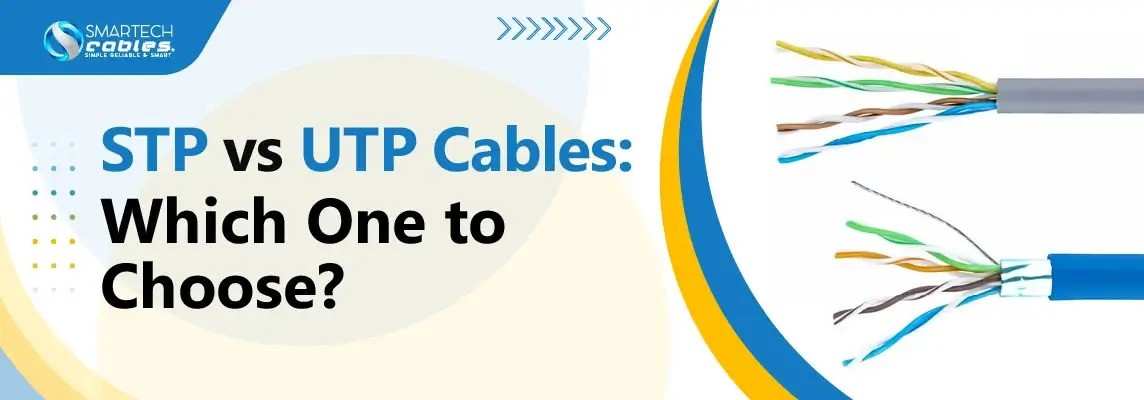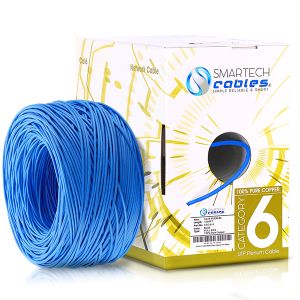STP vs UTP Cables: Which One to Choose?
STP vs UTP Cables: Which One to Choose?

Low voltage twisted-pair cables such as the Cat6 ethernet cable can be divided into two types based on this one specification: shielding. The cables that have a shielding integrated underneath their cable jacket are known as shielded twisted pair (STP) cables. And the ones that lack a protective sheath underneath their jacket are known as unshielded twisted pair (UTP) cables.
When purchasing ethernet cables for data communications e.g local area networks, you will need to choose between UTP and STP cables. Now, how do you decide which cable you need to get? And which one is ideal for you? These are some of the kinds of questions that we are going to answer in this blog.
If you are looking to buy ethernet cables and are unsure if you need STP or UTP, all of your queries shall be answered. Be sure to read till the end. Let’s dive in.
Unshielded Twisted Pair (UTP) Cables
These cables are the ones that lack a protective shielding underneath their cable jackets. For instance, the UTP Cat6 cable does not have a foil or a braided wire mesh to protect the conductors from crosstalk. Most of the latest categories of ethernet cables come with shielding. Cat6 and Cat5e cables are the most common ones that are available in unshielded variants.
Shielded Twisted Pair (STP) Cables
STP Cables have different kinds of protective mechanisms integrated just beneath the cable jackets. The STP Cat6 Riser cable is one of the many examples of shielded ethernet cables. Most Cat6a Ethernet Cables, and Cat7 and Cat8 cables are produced in shielded variants.
It is absolutely crucial in resisting EMI. For long distance transmissions, the STP cables are ideal and perform impeccably without losing signal integrity.
Types of Shielding
There are two major types of shielding in ethernet cables. The first type is foil shielding and the second one is a braided wire mesh which is also known as screen shielding.
STP cables can have either one or both types of shielding. And you will choose the one that best fits your requirements (more on that later).
Foiled shielding in cables is an aluminum foil that is wrapped around cable conductors. It can be wrapped around the individual conductor pairs or the entire conductor pair bunch.
Similarly, the braided shield can also be wrapped around the individual conductor pairs or the entire bunch of conductor wires. Moreover, both types of shielding can also be integrated into the same cable.
Know that the shielding in ethernet cables can come in various types. Choose the type of shielding you need depending on your requirements.
Which is better: STP or UTP?
Well, both types of cables are designed for different purposes. STP cables are used in networks where crosstalk can have a major effect on data transmission. UTP cables are used in settings where EMI is relatively lower and cannot have an effect on the performance of the cable.
In any case, the STP cables result in smoother signal transmission, better signal integrity, and minimum interference. However, also note that the shielding in the cable can make it a bit tricky to install the cable. For instance, the unshielded Cat6 ethernet cable is easier to install as compared to its shielded counterpart.
Guaranteed Best Price !
The Bargain
We always recommend the cable that is exactly right for your requirements. And it means that we won’t always recommend the shielded cables because they offer better signal integrity and low EMI levels. But there is always a bargain in using the shielded cables.
They not only transmit high-quality and clean signals at blazing speeds, but they also last longer than their UTP counterparts. The reason is that the shielding in these cables protects the conductors against extreme environmental conditions. Because conductors are the main part of the cable, protecting them ultimately translates into a longer lifespan of the cable.
Even if the STP cables cost a little more than the UTP cables, by lasting for far longer and performing far better than their unshielded cables, shielded twisted pair cables are a fair bargain to get.
Why Would You Use STP over UTP Cabling?
You do not necessarily need to use the STP cables over the UTP ones. If you believe your network suffers a significant amount of crosstalk, you should get the STP one. But if you believe you can make do with unshielded cables, you should get the UTP cables that are easy to install as well as offering terrific performance.
But generally, using the STP cables, in addition to better performance, results in higher productivity and provides you with peace of mind. You can rest assured that you are utilizing the best cables out there.
Which is Faster? STP or UTP?
In theory, both STP and UTP cables have the same speeds. But in practice, the shielded twisted pair cables are a bit faster as compared to their UTP counterparts. That is obviously due to the shielding. It keeps crosstalk out of the network and ensures that all the potential of the cable is used only to transfer the data you want to transfer.
On unshielded twisted pair cables, their potential is used up by unwanted signals to some extent. Even if the data transmission speed of UTP cables is not affected, the quality of the signals is much less than that of the STP cables.
Disadvantages of STP Cables
STP cables offer far fewer disadvantages as compared to the advantages they offer. But like any other product, they also have their fair share of disadvantages. The first one is their cost. As compared to the UTP cables, these cables are more expensive because installing the shielded cables costs extra.
Another disadvantage is the relatively less flexibility of the cables. This is especially problematic while installing them. Shielding makes them rigid and you will need a little more effort to run the cable.
Major Advantages of STP over UTP Cables
The following are the major advantages of using STP cables over UTP cables. Pertinent to note here is the fact that while the UTP cables may not be as good performing as STP in the following categories, they are still heavy-duty cables and can perform ideally in their design conditions.
- Better signal integrity
- Low crosstalk
- Low levels of attenuation
- Higher data transfer speed
- Longer lifespan of cable
Which One to Choose?
Choosing between STP and UTP cables is easy. For networks that have multiple cables running in parallel, STP cables are highly recommended. And for networks that do not run too many cables, UTP cables are perfectly fine.
You can make an exception if you have the extra budget and the skills to install the shielded cables. Nonetheless, we recommend using the appropriate cable for certain applications.
Best Shielded Cable to Buy
For all kinds of applications, there is one ethernet cable that we recommend and know for sure that it will cater to all kinds of needs. That is the Bulk Cat6 Cable 1000ft. It comes in two different types of jackets: Cat6 plenum and riser.
Although the unshielded variant of this cable is also a fine solution that will work impeccably, the STP Cat6 ethernet cable is particularly recommended. It features 23 AWG conductors made from pure copper (CCA also available) and offers data transfer speeds of up to 1 GBit/s over 100 meters with 550 MHz bandwidth capacity.
The cable is compatible with all previous categories of ethernet cables as well as its preceding categories. Over 50 meters, the cable can transmit data at up to 10 Bit/s.
Smartech Cables
Are you looking for innovative ethernet cables or accessories? Check out Smartech Cables. We are the industry leader in manufacturing and distributing networking cables and accessories of the highest standards. Our products exceed the industry limits and our prices are market competitive. If you need help, our professional customer support team is available at [email protected].





